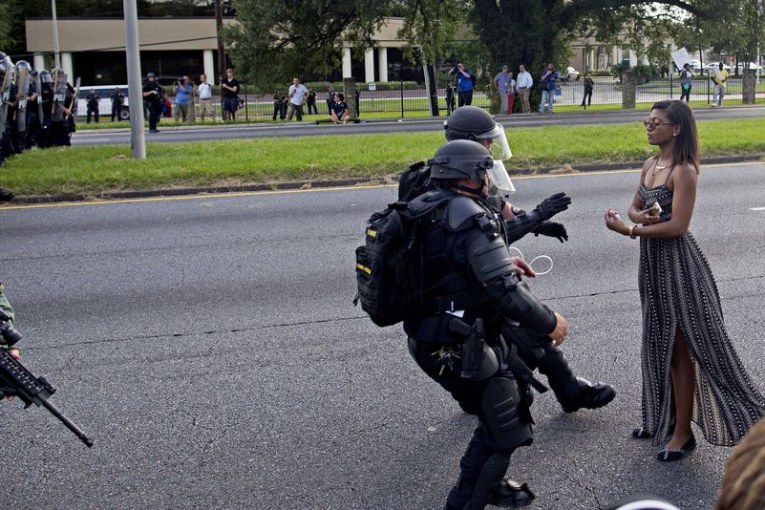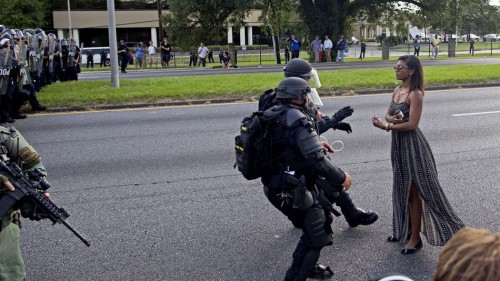

The headline in the New York Times read “Surprising New Evidence Shows Bias in Police Use of Force but Not in Shootings” and the researcher, Harvard Economic Professor Roland Fryer, calls it “the most surprising result of my career.”
The take home message, “A new study confirms that black men and women are treated differently in the hands of law enforcement. They are more likely to be touched, handcuffed, pushed to the ground or pepper-sprayed by a police officer, even after accounting for how, where and when they encounter the police. But when it comes to the most lethal form of force — police shootings — the study finds no racial bias.”
But did the Times overplay the results of the study? The study was sweeping and in a lot of ways innovative, in that it examined more than a thousand shootings in 10 major police departments – in Texas, Florida and California over a period from 2000 to 2015. At the same time, the findings may be more limited than the headlines apply.
The team spent over 3000 hours assembling detailed data from police reports in Houston; Austin, Tex.; Dallas; Los Angeles; Orlando; Jacksonville, Fla.; and locations in four other counties in Florida. They examined 1,332 shootings between 2000 and 2015.
But beneath all of that breadth of data, the key question that they examined was: “In the tense moments when a shooting may occur, are police officers more likely to fire if the suspect is black?” In order to answer that question, Professor Fryer focused on one city – Houston.
There are good reasons for that. “The Police Department there allowed the researchers to look at reports not only for shootings but also for arrests when lethal force might have been justified.” But that strongly limits the data and its applicability to the national discourse.
In Houston, “Mr. Fryer found that, in tense situations, officers in Houston were about 20 percent less likely to shoot a suspect if the suspect was black. This estimate was not very precise, and firmer conclusions would require more data. But, in a variety of models that controlled for different factors and used different definitions of tense situations, Mr. Fryer found that blacks were either less likely to be shot or there was no difference between blacks and whites.”
So, drilling down beneath the headline, we find that the dramatic headline was based on a limited study of Houston with an imprecise estimate that would require more data and firmer analysis.
Again, this is a great study, but the finding is preliminary and limited to Houston.
Also of interest, but again limited to Houston, Professor Fryer found that the rise of mobile video did not change the results.
The Times warns, “Such results may not be true in every city. The cities Mr. Fryer used to examine officer-involved shootings make up only about 4 percent of the population of the United States, and serve more black citizens than average.”
But further beneath that is perhaps a more important finding: “the results do not mean that the general public’s perception of racism in policing is misguided. Lethal uses of force are exceedingly rare. There were 1.6 million arrests in Houston in the years Mr. Fryer studied. Officers fired their weapons 507 times. What is far more common are nonlethal uses of force.”
It is in the area of nonlethal uses of force that Professor Fryer found ample racial difference in accord with public perception. Here he moved the study to New York City, probably a city that would have been more appropriate for examining the use of deadly force, as it has been at the epicenter of a number of high profile and controversial police uses of deadly force.
Here the evidence is overwhelming and unequivocal.
In New York City, “blacks stopped by the police were about 17 percent more likely to experience use of force, according to stop-and-frisk records kept between 2003 and 2013.”
This is the correct metric because it is not dependent on the number of people stopped, it simply examines the likelihood of the use of force given a stop.
That was made more robust because they were able to control for suspected behavior and other factors. “Black suspects were 18 percent more likely to be pushed up against a wall, 16 percent more likely to be handcuffed without being arrested and 18 percent more likely to be pushed to the ground.”
Those are not huge numbers, but they are consistent numbers. And they are police reported numbers.
The Times continues, “Mr. Fryer also explored racial differences in force from the viewpoint of civilians, using data from a nationally representative survey conducted by the federal government. Here, he found racial gaps in force that were larger than those he found in the data reported from the officers’ perspective. But these gaps were also consistent across many different types of force. They were as strong for civilians making more than $50,000 a year as they were for those making less.”
When it was civilian reported, the use of force against blacks was 170 percent more likely to be grabbed, 217 percent more likely to be handcuffed, 305 percent more likely to have a gun pointed. On the other hand, the number fell to 87 percent more likely to be kicked, subject to a stun gun or pepper sprayed.
Professor Fryer posits “if the difference between lethal force — where he did not find racial disparities — and nonlethal force — where he did — might be related to costs. Officers face great costs, legal and psychological, when they unnecessarily fire their weapons. But excessive use of lesser force is rarely tracked or punished. “No officer has ever told me that putting their hands on inner-city youth is a life-changing event,” he said, contrasting the consequences of shootings and lesser uses of force.”
Those are interesting thoughts, but the main problem both studies suffer from is single location. In New York, there were specific policies that might make it more likely for blacks to suffer from a use of force than in other locales. And yet we are generalizing a lot from a very limited study.
In short, while I think Professor Fryer validates the perception of bias in the NYPD, I’m not sure why anyone would want to extend those finding beyond New York. I suspect the findings in Houston may be very different.
Part of what this study does not get at is the discrepancy between officer-involved shootings of whites, who are more likely to be armed, and officer-involved shootings of blacks, who are more likely to be unarmed.
It is a good start for systematic research, but does not warrant the headline the NY Times gave it.
—David M. Greenwald reporting

With regard to medical, scientific and and sociologic experiment reporting, the pictures and the headlines frequently are latched onto for their emotional rather than their factual impact. I like to think of myself as attempting to make objective assessments of sets of information. And yet, this morning when I first looked at the new articles, what struck me first and still after taking the time to read the article has left me emotionally affected is not the article ( which is much appreciated) but rather the accompanying photo.
I had two immediate thoughts that I have not been able to shake. The first was how much the photo reminded me of Kent State with unarmed protesters confronted by heavily armed National Guard. And then I made a second realization. At the time of Kent State it was not the local police, or in the case of the pepper spray incident at UCD the campus police that were geared as though for military action, it was the National Guard. Now, it is the local departments that are employing this level of military gear and tactics to confront unarmed if disobedient citizens.
I cannot help but ask “Is this really the kind of response that we want to an unarmed civilian who is simply non compliant regardless of the color of that persons skin ?”
Given the level of public concern and inflammatory uproar around this issue, I don’t see why the FBI and/or CDC can’t do a comprehensive rigorous high-quality statistical study like this for all cities and large towns in the USA (and later maybe even smaller towns). Instead of endless assertions by those on both sides of this issue; we could deal with actual facts re: systemic differences in treatment of different races by the police. This limited-area study strongly suggests that the perception of strong systemic police bias in treatment of blacks does not match the reality on the ground (though some small differences do exist)–my hypothesis for the mismatch is that the mis-perception has largely been created by the mainstream media, activists, and politicians who stand to benefit from such wedge issues and identity politics. The powers-that-be in this country stand to benefit greatly if they can keep the attention and energy of the population squabbling about racism; not noticing that meanwhile a larger and larger proportion of the national wealth is being consolidated into the ownership of fewer and fewer people–god forbid that poor blacks, whites, and hispanics should unite and make common cause for the many problems common to the poor of all ethnicities; no, we need to make sure they strongly self-identify by race, keep up the racial tensions and help ensure they don’t unite!
Short answer is “resources”… money and human resources (also, money)… unless you believe those folk are under-worked, that effort would come at the ‘expense’ of other normal activities… or require a ramping up of resources…
I believe that they “can” do it, but choices would need to be made to do so…
These studies really don’t cost that much. Especially compared to the budget of a federal agency.
Having a research of the caliber of the Harvard professor is better than the FBI is going to be able to do.
Also, NOT having a preconceived notion of what the result will be before the study is helpful, damn near incredible. Most Grants are to prove results: your numbers have to make them valid, or no Grant money.
The Guvmint will not give money to “studies” they don’t want to know results for.
tribeUSA wrote:
> I don’t see why the FBI and/or CDC can’t do a comprehensive rigorous
> high-quality statistical study like this for all cities and large towns
It will be a waste of time since we all know the odds of the FBI saying we have cops breaking the law that need to go to jail is LESS likely than a new FBI report that says Hillary is breaking the law and needs to go to jail…
You can see a potential explanation for why the cops would be more physical with black suspects by just watching the BLM protests and how the average protestor interacts with the cops. You can see a potential explanation for why the cops would be more physical with black suspects by listening to the likes of Al Sharpton and Jessie Jackson bait racism and seed anger against the cops that manifests in more hostility toward the cops.
I post this assuming it will offend some, but aside from the raw and politically-incorrect humor, it makes the point.
https://youtu.be/igQDvYOt_iA
The data is too pervasive to explain it based on protests. Also you’re still defending prejudice in your explanation – black people = BLM protesters based strictly on skin color.
Explain it based on group behavior that translates into individual behavior. Some tribes are more confrontational and physical than others.
You’re just using different words to describe racism and trying to convince yourself it’s not.